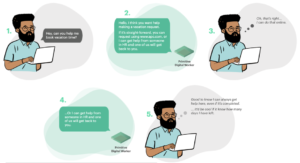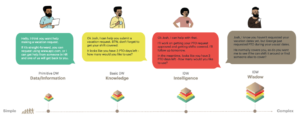
post
December 20, 2021
Spending Quality Time With IDWs
As an organization’s skills, conversational AI, and ecosystem evolve, IDWs start to feel more like colleagues. They have skills that are helpful in collaboration or independently, and they can get things done.
Think of an IDW as a new colleague in training. Imagine the IDW is in HR, training with Yvonne, a department supervisor, to become an expert in managing the approval processes and scheduling for paid time off.
This is a complex task given the amount of context the IDW needs to decipher:
• How much remaining PTO does the employee have?
• How many shifts will need to be covered?
• Who is available to cover these shifts?
• Are there any conflicts with the dates re- quested?
Yvonne is an expert in these areas, so she trains the IDW to follow an ideal process. This often overlooked factor in creating force multipliers is crucial. Just like our earlier example of automat- ing a coffee maker demonstrated, greater im- pact comes from not just automating tasks to be done how people are already doing them, but to actually improve the process, You’re empowered to design processes that can be tackled by an unlimited number of workers.
User: I’d like to book some vacation time.
IDW: Ok, I can help you request time off. What days off would you like to request?
User: July 15th through the 22nd.
IDW: Ok. I’ll work on filing a request for July 15th through July 22nd. Would you like me to see if someone is available to cover your shifts?
User: That would be great.
Once the IDW is operational, one of the ways it can continually contrib- ute to its own evolution is by making use of its human-in-the-loop (HitL) skills, meaning it can reach out to Yvonne or her colleagues for help whenever it gets stumped.
IDW: Would you like me to see if someone is available to cover your shifts?
User: That would be great. Can you see if Carl is available to cover my Wednesday shift that week? He and I have been working on a project together and there’s a project meeting that day.
IDW: I’m not sure I understand the request. Let me grab a human to help …
Tracing An Example Through Evolutionary Stages
Let’s trace an example skill, helping employees to request paid time off, through four evolutionary stages. The following illustrastions depict what it might be like for our user, Josh, to interact with the same skill at various phases in it’s evolution.
The Data And Information Literacy Stage

The Knowledge Stage

The Intelligence Stage

The Wisdom Stage

The Evolution Of A Skill: 4 Evolutionary Stages
Stages are named for their most significant area of advancement.

Stay up to date
Latest Articles

OneReach.ai Named a Leader in the IDC MarketScape for Conversational AI Software 2023
December 18, 2023


